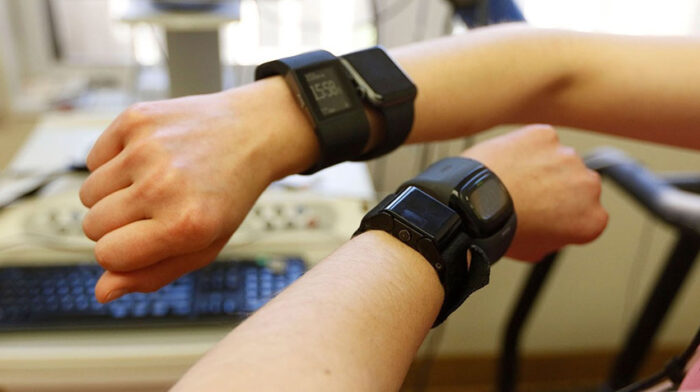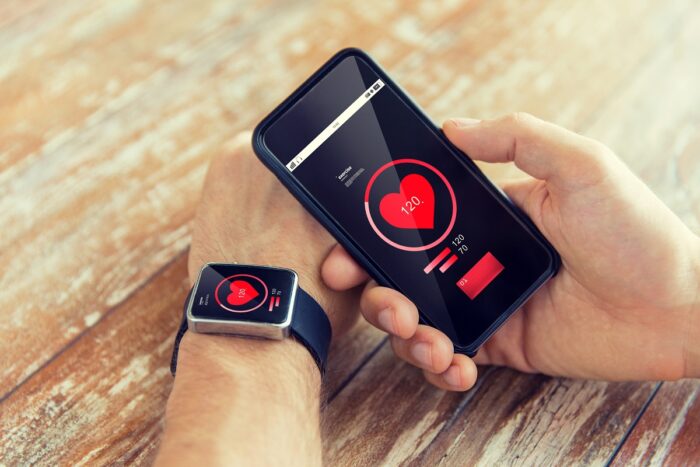Understanding Heart Rate Variability (HRV) and its Importance in Fitness Tracking
Heart rate variability (HRV) is a captivating metric that captures the enigmatic variation in time intervals between heartbeats. It unveils profound insights into our autonomic nervous system, unraveling the delicate equilibrium between our sympathetic and parasympathetic branches. This extraordinary information proves to be invaluable in the realm of fitness tracking, as it grants us an intriguing glimpse into how our bodies adapt and recover from stressors during periods of rest.
The advent of wearable devices, such as fitness trackers, has ushered in a revolutionary era for monitoring HRV. These innovative gadgets employ sensors like optical heart rate monitors or chest straps to continuously capture HRV data throughout each passing day. By donning one of these marvels – whether it be an Apple Watch or Fitbit – individuals can effortlessly track their resting heart rate while harnessing the power of HRV to optimize their training regimens.
Comprehending HRV empowers us with the ability to assess our body’s remarkable capacity to navigate diverse circumstances and perform accordingly. A heightened state of HRV signifies superior levels of overall health and fitness, whereas a diminished level might indicate exhaustion or overexertion. Armed with this knowledge gleaned from observing fluctuations in HRV over time, individuals can make astute decisions about when to intensify workout sessions or indulge in well-deserved days dedicated solely to recovery.
Incorporating HRV into your fitness routine not only amplifies performance but also fosters holistic well-being. Embracing wearable technology as a means to measure this consequential metric bestows upon you precious insight regarding your body’s intricate response patterns towards exercise and life’s various stressors throughout any given day. So next time you fasten your trusty fitness tracker around your wrist, take heed not just on steps trodden nor calories incinerated; instead plunge deeper into comprehending those mesmerizing rhythms pulsating within by embracing the enchantment bestowed by measuring HRV.

Exploring the Role of Wearable Devices in Tracking HRV
The advent of wearable devices has completely transformed the manner in which we monitor and keep tabs on our health. A domain where these devices have made notable strides is in the tracking of heart rate variability (HRV). HRV alludes to the fluctuations in time intervals between successive heartbeats, furnishing crucial revelations about our overall cardiac well-being and stress levels. Thanks to wearable devices such as smartwatches or Oura rings, individuals can now effortlessly gauge their HRV each day.
A pivotal aspect of wearable devices designed for HRV tracking lies in their capacity to offer real-time measurements with utmost precision down to milliseconds. This implies that one can obtain instantaneous feedback regarding their HRV throughout the course of a day, enabling them to fathom how their body reacts under different circumstances or engagements. By way of illustration, if an individual notices a significant drop in their HRV subsequent to a particularly stressful work meeting, it may indicate activation of the sympathetic nervous system responsible for orchestrating the body’s stress response.
By consistently monitoring one’s HRV through employment of a wearable device, invaluable insights into how various lifestyle factors impact stress levels and general well-being are obtained. For instance, studies have demonstrated that regular physical exercise contributes towards augmented HRV over time—a testament to enhanced cardiovascular fitness and reduced stress levels. Conversely, chronic stress or inadequate sleep quality might precipitate lower values on the HRV spectrum.
To summarize,
wearable devices provide convenient avenues for monitoring one’s HRV while simultaneously offering valuable glimpses into both cardiac wellness and responses towards stressful stimuli. Armed with features like real-time measurements coupled with comprehensive analyses pertaining to hrv data,
these remarkable gadgets embolden individuals by affording them greater control over their state of being through informed decision-making vis-à-vis lifestyle choices.
The Science Behind HRV: How Does it Measure Heart Health?
Heart Rate Variability (HRV) is a metric that delves into the enigmatic realm of time intervals between consecutive heart beats. It unravels the perplexing tapestry of your cardiac rhythm, offering profound insights into the well-being of your precious heart. By scrutinizing HRV trends over time, you can unlock the mysteries surrounding your heartbeat and unveil potential issues lurking beneath.
To uncover this enigma, wearable fitness trackers equipped with heart rate sensors emerge as the chosen tools. These technological marvels delve deep into the electric symphony playing within your chest, meticulously calculating HRV readings by deciphering variations in each beat’s interval. The trove of data amassed by these trackers can be seamlessly synchronized with apps like Apple Health, which serve as portals to a world brimming with intricate analyses regarding your HRV trends.
A harmoniously pulsating HRV validates robust cardiovascular health, signaling an optimally functioning autonomic nervous system at its core. Elevated values indicate an adaptable autonomic nervous system capable of gracefully navigating stressors while maintaining equilibrium. By vigilantly monitoring fluctuations in HRV, you gain unparalleled insight into shifts in overall cardiac well-being—knowledge that empowers informed decisions about necessary lifestyle adjustments to safeguard or enhance it.
Armed with wearable fitness trackers and apps such as Apple Health, you embark on an extraordinary journey through continuous hrv tracking throughout each day—a voyage where exercise intensity merges effortlessly with sleep quality; where stress levels intertwine intricately with respiratory rate—and all converge upon shaping your unique hrv trend. Armed with this wealth of information derived from their ever-watchful gaze upon these factors’ impact on your cardiac vitality—you stand primed to unleash optimal cardiovascular health for remarkable performance.

The Relationship Between HRV and the Autonomic Nervous System
The autonomic nervous system, a critical regulator of various bodily functions, notably heart rate, is an enigmatic force. Heart rate variability (HRV), a metric that gauges the fluctuation in time intervals between consecutive heartbeats per minute, unravels profound insights into both the functioning of this mysterious system and overall cardiac well-being.
Startling research has unearthed the significance of overnight HRV as a cardinal barometer for cardiovascular health. Astonishingly, studies have revealed a disconcerting truth: individuals with diminished HRV face heightened peril from heart disease. The dwindling HRV betrays an inflexible and unadaptable nature within the autonomic nervous system, culminating in elevated resting heart rates and potential cardiovascular complications.
By harnessing cutting-edge wearable technology like fitness bands or smartwatches to amass HRV data, one can embark on an odyssey towards comprehending their personal fitness prowess and wellness standing. Take Fitbit’s ingenious app as an illustrative example; it empowers users to diligently monitor their HRV through daily measurements derived from heart rate variability assessments. This invaluable trove of information holds the key to unravel patterns and trends concerning stress levels, post-exercise recovery kinetics, and overarching cardiac functionality.
In essence, quantifying HRV serves as an indubitable gateway for evaluating your autonomic nervous system’s vitality while concurrently deciphering its intricate interplay with holistic prosperity. An exalted state of high heart rate variability heralds not only a nimble but also adaptable autonomic nervous system synonymous with exemplary cardiovascular well-being. Conversely, low HRV figures cast ominous shadows by hinting at augmented susceptibility to debilitating maladies such as coronary artery disease or other latent health afflictions lurking beneath the surface. By seamlessly incorporating wearable devices equipped with advanced HRV tracking capabilities into your exercise regimen, you can gather precious pearls of wisdom regarding your body’s response to diverse stimuli encompassing stressors and exercise intensities alike.
How to Measure HRV with Wearable Fitness Trackers
The perplexing world of HRV measurement through wearable fitness trackers unveils itself through the utilization of built-in heart rate monitors. These fascinating devices employ optical sensors, capturing the rhythmic beat of your heart and presenting real-time data on the variability of your heart rate. Optimal results are achieved when measurements are taken during moments of rest, establishing a baseline reading for comparative purposes.
To comprehensively decipher the HRV readings from your technological wearable, it is crucial to grasp that HRV is intrinsically linked to fluctuations in heart rate triggered by an array of factors including respiration rate and autonomic nervous system activity. An average HRV reading signifies robust health and fitness levels, while a decrease in HRV may serve as an ominous indication of stress or fatigue lurking within.
Enigmatic revelations arise during slumber as it becomes apparent that HRV experiences ebbs and flows contingent upon various elements such as sleep quality and stage. Certain wearables even offer specialized capabilities aimed at monitoring HRV throughout this state, providing invaluable insights into one’s overall well-being.
A plethora of options await those who wish to delve into measuring their own HRV utilizing wearable fitness trackers. The favored choices encompass Apple Watch applications harnessing the device’s innate sensors alongside chest strap monitors renowned for their precision accuracy. Irrespective of which path you embark upon, diligently monitoring your personal HRV paves way towards effectively tracking cardiac vitality alterations while simultaneously augmenting holistic fitness endeavors.